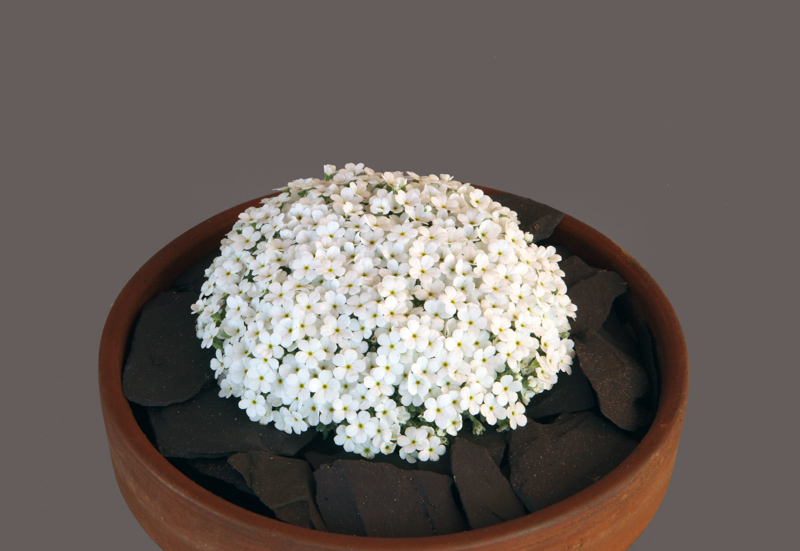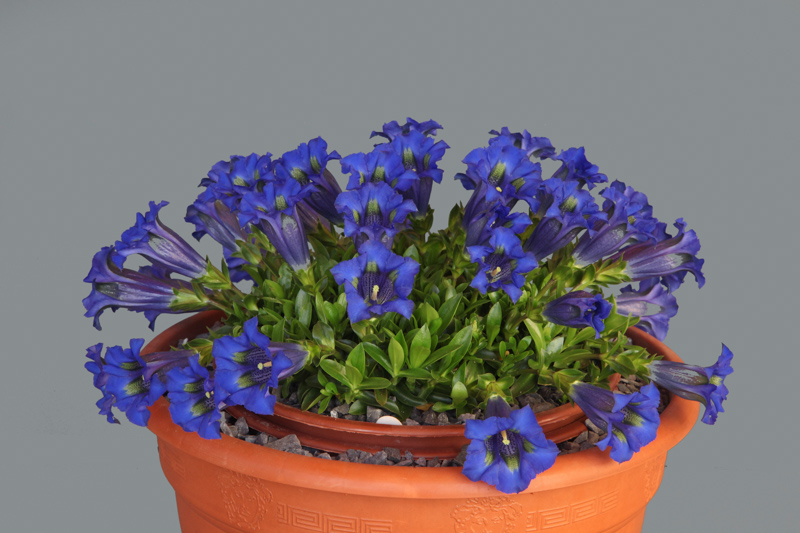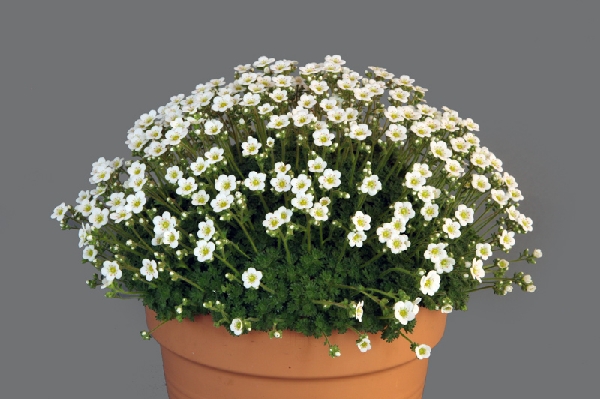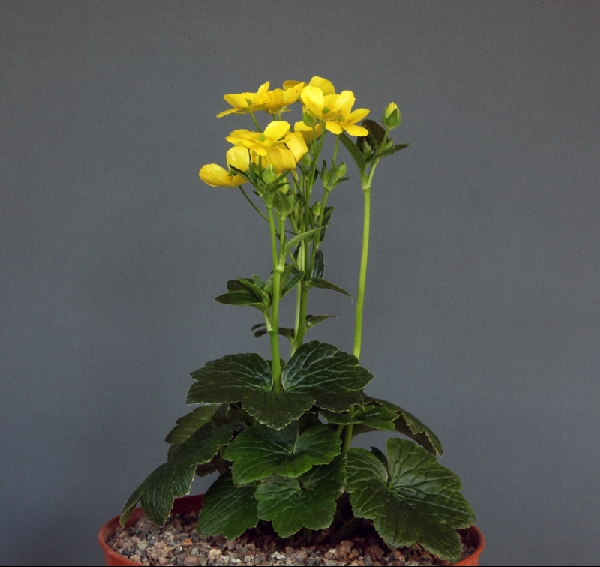Ulster AGS Show, 2015
Those of us who have been attending AGS shows for many years sometimes forget the impact a really good one can have on a first time visitor. I reflected on this at Greenmount when surveying the exceptional display across the benches at this year's Ulster fixture. The fact that there were eight candidates for best plant says it all. It reminded me of the sense, almost of awe, that I felt many years ago when I attended my first AGS show in Belfast.

It reminded me also that the annual show is the local AGS Group's shop window, offering a prime opportunity to recruit new members. In the Dublin Group most of our new members join either at, or shortly after the show. This highlights the importance of the shows for the future health of the Society, and the importance of maximizing their potential to attract new members. Laurence Kane, who was awarded the trophy for the best plant in flower in the Novice Section, took up gardening only three and a half years ago, and, influenced by what he saw on the benches, joined the AGS. His winning plant was an excellent Androsace vandellii that would not have been out of place in the Open Section. All AGS groups need to attract more Laurence Kanes.
As usual thanks to Pat Crossley and her team who got everything right, and to Don Peace, whose calm and efficient direction (with the able assistance of George Sevastopulo whenever one of Don's plants was in contention) ensured the judging went smoothly. Exhibitors from the Ulster and Dublin groups were joined by Don from England, and Ian Leslie from Wales, both of whom were most welcome and made no small contribution to the excellence of the show.

The Farrer Medal went to Paddy Smith's superb specimen of Gentiana acaulis, repeating his success at the Dublin show in 2014 when his large pan of G. verna received this award. He obviously has a way with gentians, for he had no less than twelve on the bench, some representing G. verna (including the white form), some G. acaulis, some in 19cm pots, others in larger ones, all grown from seed and all potential award plants. Is this a record? He makes his own compost using the John Innes formula but substituting Vitax Q4 fertilizer. He then mixes one part of this with one part of leaf-mould and two of grit, adding a little lime for G. verna. The plants are grown in plastic pots, kept outside at all times, never allowed to dry out, with the roots kept cool in summer by double potting. Paddy also took home a Certificate of Merit for one of his pots of G. verna.

The award for the best plant in the Intermediate Section went to Kay McDowell's Saxifraga pubescens 'Snowcap'. Like Paddy, Kay makes up her own mix, consisting of garden soil, perlite, garden compost and slow-release fertilizer. The plant, six or seven years old, lives in a cold frame.

Harold McBride won an AGS Medal for his fine entry in the large six-pan class. A Certificate of Merit went to one of its components, the imposing Ranunculus cortusifolius, native to the Canaries and the Azores but naturalized in California and popularly known as the Giant Buttercup. Harold grew it from seed and keeps it in his alpine house in a deep pot, in a humus-rich, free-draining compost, with occasional liquid feeds and plenty of moisture while in growth. Aphids can be a problem.
37683.jpg)
The award for the best ericaceous plant was given to Susan Tindall's impeccable Cassiope 'Snowbird', a cultivar raised by Mike and Polly Stone. Susan finds it a willing grower, keeping it in a tunnel in a standard ericaceous compost and ensuring that it never dries out. Cilla Dodd's exhibit of the same plant, labelled Cassiope 'Askival Snowbird', was judged the best ericaceous plant in the Novice Section. There were fewer ericaceous plants on the benches this year than is usual.
37684.jpg)
The best plant from Australasia was Anisotome imbricata from Don Peace, one of two which he exhibited. Don grew them from the same batch of seed, obtained from a New Zealand supplier and sown in 2006. They were quite different in appearance, one very tight with tiny, olive-green rosettes (my favourite), the winner a richer green with slightly larger rosettes. They are grown in a gritty ericaceous mix and increase very slowly. The flowers are rather drab.
37685.jpg)
Don also showed several specimens of Androsace vandellii, the largest adjudged best plant in a pan not exceeding 19cm. He follows Geoff Rollinson's growing regime, using a compost consisting of one part leaf-mould and two parts grit and recommends standing the pot in a soak tray for half an hour in early January to prevent the flower buds from aborting. Throughout the summer the pots are plunged in a shaded alpine house. The plants, repotted yearly when small, are later on kept in a 19cm pot for as long as possible, with occasional feeds of Chempak no. 8.
37686.jpg)
A Certificate of Merit was awarded to Don for a very large pan of a 15 year old Cystopteris dickeana, every frond a pristine, bright, fresh green. This plant germinated fortuitously in the plunge in his alpine house and grows in a recycled gritty mix (formerly enjoyed by his fritillarias), with occasional liquid feeding. Kept in the alpine house early on, it goes outside in suitable weather and the dead fronds are removed in January.
37688.jpg)
For the record, the award for most first prizes in the Open Section was won by Don; in the Intermediate Section by Frank Lavery; and in the Novice Section by Elizabeth Ross.
37689.jpg)
Two plants shown by your reporter received Certificates of Merit. One went to a large pan of Calceolaria 'Walter Shrimpton' [above], which is not particularly difficult but utterly unforgiving if it becomes infested by aphids, or dries out. I find that it requires copious watering when in active growth and in flower. The other, a mature potful of Pulsatilla albana grown from seed sown in 2009, has been in the same clay pot for four years, kept outside all year, and given a feed of Tomorite after flowering.
37687.jpg)
Drakensberg gentian relative Sebaea thomasii is a plant of which I am fond but find difficult to keep in good condition when it reaches maturity. Tim Lever of Aberconwy Nursery, of course, has mastered this species, not only winning a Farrer Medal both this year and last, but also growing a large specimen in the crevice bed at the family nursery. Hugh McAllister of the Ulster Group, however, grows this plant very well too, and received a well-deserved red sticker for his exhibit. Hugh keeps his plant outside except in severe weather. [Photo: Hugh McAlister's S. thomasii]
Joan and Liam McCaughey once again dominated the Photographic Section, as they do at so many shows, and with fifteen first prize points took home the John McWhirter Award.
In Ireland the two shows in Ulster and in Dublin are held in April, so there is always a certain sadness when the later one ends, as we have to wait a year for the next. There is some consolation to be had for exhibitors from the fact that with the show season over we can attend to our gardens, and perhaps apply the lessons learned from the current year's shows, nurturing potential candidates for the show bench next year.
Author: Billy Moore
Photographer: Heather Smith
